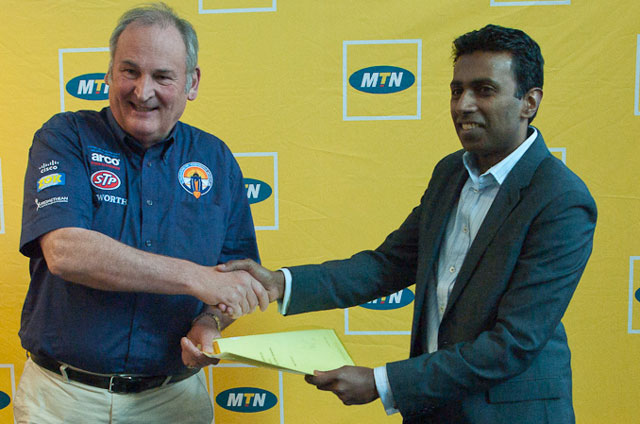MTN SA has signed a sponsorship deal with Bloodhound SSC (supersonic car), a UK-based project that bills itself as an “engineering adventure” and seeks to break the land-speed record by piloting a vehicle at more than 1 600km/h.
The companies hope to use the project to encourage school pupils in SA and the UK to study science, engineering and mathematics.
Lambo Kanagaratnam, chief technology officer at MTN SA, says the Bloodhound SSC project is a three-year “mission” to create a supersonic car.
The run is set to take place in 2014 at the Haksteen Pan between Upington and the Namibian border in the Northern Cape. A 19km-long, 500m-wide track is being cleared of debris, by hand, by 370 people from the local community. More than 21m square metres of stones are being removed and more than 6 000t has been cleared to date.
MTN will upgrade its towers in the region with fibre backhaul so that it can offer LTE — long-term evolution, or next-generation mobile broadband — at the pan.
“The two towers in the region have Edge now, but will soon have [high-speed packet access] and LTE capabilities with backhaul to Upington,” says Kanagaratnam.
Although it is unlikely an LTE connection to the vehicle will be sustainable at 1 600km/h, he says MTN is interested in finding out at what speed the vehicle starts losing signal.
Bloodhound SSC project director Richard Noble says the project is “enormous” and involves more than 200 companies.
All data, including details of the vehicle’s design, will be made available online. Many of the technical diagrams are already available. All performance data is to be released after each run.
Schools are being encouraged to follow the project online and Noble says there are 160 schools in SA tracking the project already.

Dave Rowley, education programme director for Bloodhound SSC, says 60 schools in the Northern Cape are tracking the project, with more to follow.
“It would be great to just point them to the Internet like we do in the UK, but that’s not always possible in SA, so we’re looking at providing information in different formats,” Rowley says. “We know the only way we’re going to satisfy requests for information is by sending ambassadors to schools to talk about the project.”
The vehicle will be powered by a jet engine and a rocket, offering combined horsepower of around 135 000hp. It will travel at 1,4x the speed of sound. It will be 12,8m long and produce 25x the noise level of a jumbo jet taking off. While attempting to break the land speed record, it also looks set to break the low-level airspeed record as it is designed to be 320km/h faster than the Eurofighter jet.
The only stipulations for land-speed record vehicles are that they have four or more wheels and a driver. “There are four or five other vehicles being built at the moment, but each design is unique.”
In order to make the project possible, Bloodhound has developed its own rocket motor that generates 27 000 pounds of thrust and 77 000hp. The vehicle will include a Cosworth CA210 Formula One engine to drive the fuel pump alone.
Other sponsors of the project include Rolls-Royce, Hewlett-Packard and Intel. The cost of the project to date is R75m. A full-scale model will tour the UK and SA in December 2012. The vehicle is expected to be operational in SA in 2013 with the run set to take place sometime in 2014. — (c) 2012 NewsCentral Media




